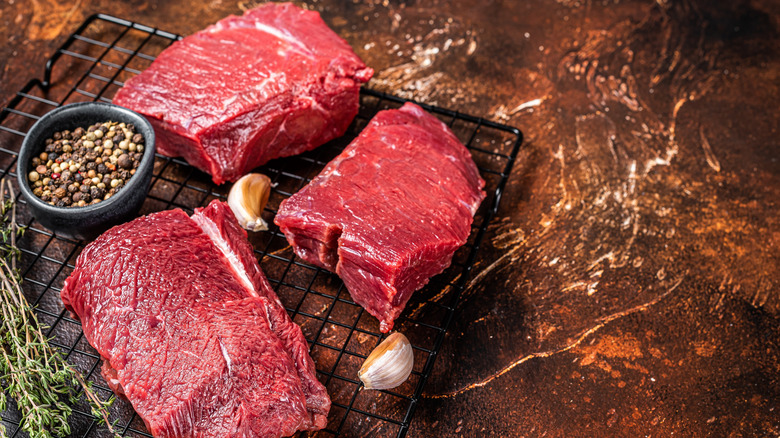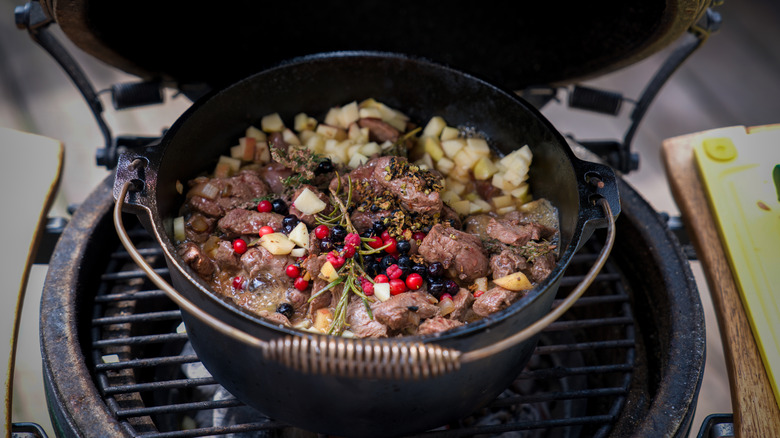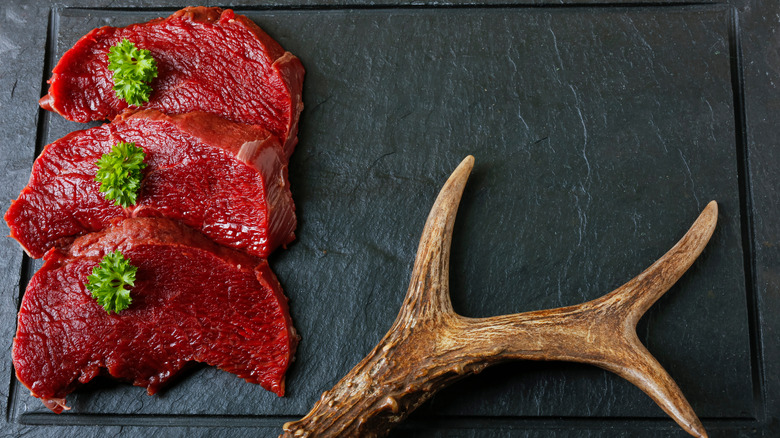What's The Best Way To Cook Venison?
Lean, flavorful, and unique enough to spark plenty of dinner conversation, venison is tasty but tricky to cook. However, its natural flavors mean you don't have to lean so much on additional spices and flavorings to make it delicious. To find out the best way to cook venison, Food Republic spoke with chef Thomas Odermatt, founder and CEO of Butcher's Bone Broth.
"Venison is a deeply flavorful meat, and I do believe less is more," Odermatt told us. "I do like a crust, thus I use a mix of garlic and onion powder, mix a pinch of cinnamon, nutmeg, and a pinch of salt and pepper. Use this mix lightly on the venison cut." Small amounts of strong spices are the best way to season venison as they uplift the meat's natural flavors without smothering them. Were you to use a large amount of softer spices, like paprika or thyme, you'd get more crust but run the risk of it tasting like any other cut of red meat.
This rule is especially important when cooking backstraps, the filet mignon of venison. While other cuts, like round, may need some work to keep them from tasting too gamey, backstraps, ribs, shoulder, and shank are largely immune to this problem. However, knowing how to remove the gaminess from venison is an important part of cooking with it regularly. From Chinese blanching techniques to massaging it with alcohol, there are plenty of ways to ensure your venison's best flavors stand out.
How to remove gaminess from venison
A deer's natural diet is usually to blame for the gamey flavor often reported by venison eaters. Tangy and earthy, it can put people off the meat entirely as some say it tastes similar to spoiled meat. However, unlike the taste of spoiled meat, gaminess is easily removed.
If you plan to braise or stew your venison, try parboiling it first with whole spices like cardamom, hawthorn berries, and bay leaf. This is a common Chinese practice used to remove impurities from meat that rises to the surface of the water as a soapy looking, easily skimmed-off scum. It's a fantastic way to remove rather than cover up gamey flavor and has the additional benefit of leaving you with a smooth, velvety sauce or soup.
If you plan to grill or roast your venison, soak it beforehand in buttermilk. The blood, myoglobin, and other factors that cause gaminess diffuse from the meat into the surrounding liquid, which can be rinsed off before cooking. Additionally, a milk bath is the secret to tender steaks, and this applies equally to everything from whole venison roasts to filets. Planning any gaminess treatment before you cook your venison is incredibly important, regardless of how you prepare it.
Differences between cooking beef and venison
Aside from its deliciously unique taste, the biggest difference between cooking beef and venison is that deer have much less fat. This means their cuts often come to temperature much more quickly, so you'll need to compensate with a marinade or a shortened cooking time. It should be noted that ground venison is largely immune to this rule but it will brown much faster since it has fewer juices.
For dry heat methods like grilling, broiling, or roasting, there are no firm rules for converting beef cooking times to venison. However, it's recommended you reduce the "doneness" of your meat by one increment to ensure it doesn't dry out. For example, if you like your sirloin roast done to medium-well, reduce a backstrap roast to medium. If you like a one-inch thick filet at medium-rare, cook a venison filet to rare. If you are set on a specific level of doneness for a recipe but want to substitute beef with venison, be sure to marinate the cut overnight in a basic marinade to guarantee its juiciness.
If you thought beef shank and chuck were tough cuts, venison versions are filled with even more heat-soluble collagen. This collagen breaks down between 160 and 300 degrees Fahrenheit, making them perfect for stew and pot roast simmers. However, unlike dry heat methods, you'll need to extend the cooking times. Check your deer meat every so often to ensure it's tenderizing properly and plan for an extra hour or so of simmering to have dinner ready on time.



